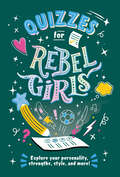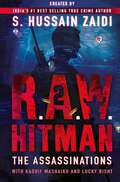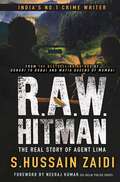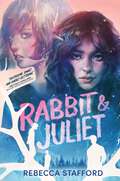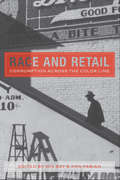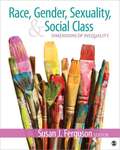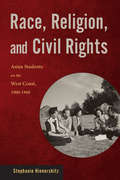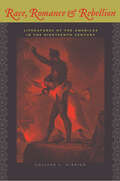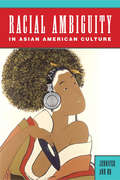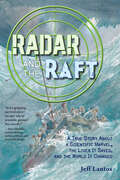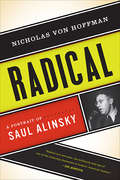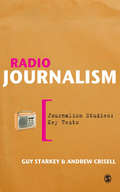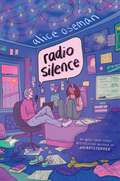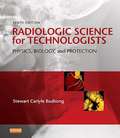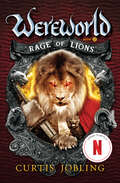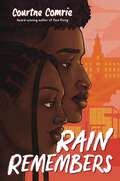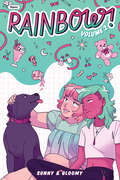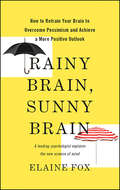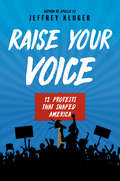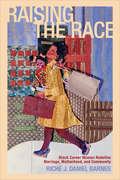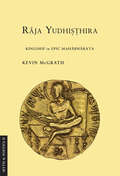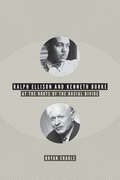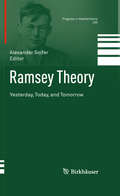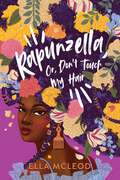- Table View
- List View
Quizzes for Rebel Girls
by Rebel GirlsIt&’s a bird, it&’s a plane, it&’s a . . . Rebel Girl! Are you:A. Flying high in the sky like adventurous pilot Amelia Earhart?B. Catching air like Olympic skateboarder Sky Brown?C. Climbing your way into the clouds like mountaineer Junko Tabei?Quizzes for Rebel Girls is packed with 30+ quizzes guiding girls to discover the traits, strengths, and habits that make them unique. The quirky questions in this book will help curious readers explore their personalities, forecast their futures, and find common ground with extraordinary women who&’ve come before. Colorful illustrations bring this book to life and make it extra fun to share with friends and family! This book is filled with playful quizzes like: Lights, Camera, or Action? What&’s Your STEM Style?Are You a Team Player? How Do You Use the Power of the Pen?Hometown Hero or World Traveler? What Is Your Super Power? Quizzes for Rebel Girls is brought to you by the team behind the New York Times best-selling series Good Night Stories for Rebel Girls. It can be perfectly paired with Questions for Rebel Girls, filled with silly, serious, and thought-provoking questions that introduce readers to extraordinary women throughout history and ask them to imagine themselves in similar scenarios. Girls love to explore their feelings, uncover their personalities, and decode the world around them. Get exploring with Rebel Girls!
R.A.W. Hitman 2: The Assassinations
by S. Hussain Zaidi Kashif MashaikhIn the deadly games of espionage, there are men who kill and disappear without a trace. Agent Lima is one of them—highly trained, efficient and ruthless, an elite operative of India&’s most secretive intelligence agency. R.A.W. Hitman 2: The Assassinations unravels the story of how this nameless operative rose to become the most feared weapon in India's covert arsenal. As Lima plunges into the underworld of fake currency, double agents, and high-stakes betrayal, he faces enemies who are willing to die to protect their secrets. Whether infiltrating the dangerous confines of the Almora Jail or navigating the criminal labyrinth of Kathmandu, Lima must play a deadly game, earning the trust of hardened criminals while maintaining his cover. But with each move, the noose tightens. One mistake could cost his life—and India&’s future. In the shadows, orchestrating it all, is Colonel Sobhraj, a man who commands from the background, invisible yet ever-present. Their relationship is built on silent trust: Lima is the executioner, while Sobhraj guides him through dangerous terrain. From luring arms dealers to taking down counterfeit networks flooding India&’s economy, every move brings Lima closer to the hidden kingpins. But even as Lima outsmarts his enemies, the ghosts of his past loom larger. Each mission pushes him further into the void where the lines between loyalty and betrayal blur. Agent Lima must use every trick he&’s learned to hunt down his targets while evading those who seek his death. His legend grows in whispers, in the cold breaths of those who never saw him coming. These are the untold origins of a man who operates in the realm where only the deadliest survive. R.A.W. Hitman 2: The Assassinations is a gripping saga of loyalty, deception and ruthless precision that will leave you breathless until the very last page.
R.A.W. Hitman: The Real Story of Agent Lima
by S. Hussain ZaidiIn September 2011, the double murder of gangsters Raju Pargai and Amit Arya rocked the Indian state of Uttarakhand. Pargai, who was well on his way to become a national security threat by smuggling weapons into India, had risen up the ranks of criminal quickly—but that also made him the target of Indian intelligence agencies, which then ordered the covert assassin named 'Agent Lima' to put him down. The day after the murder, Laxman 'Lucky' Bisht—an NSG commando who had also been the personal security officer for politicians such as L.K. Advani and then CM of Gujarat, Narendra Modi—was arrested from his home in Haldwani, accused of the double murder. Thereafter begins a tale shrouded in mystery and suspense. Was Agent Lima and Lucky Bisht one and the same person? And if they were not the same person, why did Lucky Bisht languish in prison for more than five years, being transported from jail to jail, his bail application denied, if he was working for the government?Master thriller writer S. Hussain Zaidi is back with a tale of intrigue and deceit in R.A.W. Hitman: The Real Story of Agent Lima. Based upon true events, this book will keep readers on their toes right till the end.
Rabbit & Juliet
by Rebecca Stafford"Toothsome, smart, and darkly glittering, Rabbit & Juliet is a tour de force and one of my favorite reads of the year." —Brittany Cavallaro, New York Times bestselling author of A Study in CharlotteMixing the complicated queer love from People Like Us and the dark snark of Do Revenge—with searing commentary on misogyny and rape culture à la The Female of the Species—Pushcart Prize–winning author Rebecca Stafford wraps a haunting story inside an irreverent contemporary novel about agency, grief, and toxic first loves.Seventeen-year-old Rabbit has been struggling to stay above water since her mom died. In the span of a year and half, her small Georgia town has become unbearably hellish: Her ex-boyfriend, resident golden boy Richard, turned into an unrelenting stalker; her friends are nonexistent; and her dad is campaigning hard for Functioning Alcoholic of the Year.But all that changes when the sarcastic, gorgeous, and frustratingly impenetrable Juliet Bergman walks into Rabbit’s life. All hard angles and James Dean bravado, Juliet throws Rabbit a life preserver just before her depression threatened to sink her.Then one morning, Rabbit’s ex-best-friend Sarah—Richard’s current girlfriend—shares a horrific discovery about Richard and his crew that pitches Rabbit back into darkness. The three girls vow to enact revenge on the boys for what they’ve been doing to unsuspecting girls at parties. With Juliet leading the charge and demanding blind loyalty from the girls, Rabbit falls harder for her than she thought possible. It isn't until Rabbit is faced with a startling act of violence that she must decide how far she's willing to go—for herself, for Juliet, and for justice—when love and grief threaten to topple everything.
Race and Retail: Consumption across the Color Line
by Jerome D. Williams Geraldo L. Cadava Ellen D. Wu John W. Heaton Azure B. Thompson Stacey A. Sutton Johana Londoño Anne-Marie G. Hakstian Erualdo R. González Geraldine Rosa Henderson Siobhan Carter-David Professor Ann Fabian Sharese N. Porter Traci Parker Bridget Kenny Neiset Bayouth Melissa L. Cooper Naa Oyo Kwate Sophia R. Evett Professor Mia BayRace has long shaped shopping experiences for many Americans. Retail exchanges and establishments have made headlines as flashpoints for conflict not only between blacks and whites, but also between whites, Mexicans, Asian Americans, and a wide variety of other ethnic groups, who have at times found themselves unwelcome at white-owned businesses. Race and Retail documents the extent to which retail establishments, both past and present, have often catered to specific ethnic and racial groups. Using an interdisciplinary approach, the original essays collected here explore selling and buying practices of nonwhite populations around the world and the barriers that shape these habits, such as racial discrimination, food deserts, and gentrification. The contributors highlight more contemporary issues by raising questions about how race informs business owners' ideas about consumer demand, resulting in substandard quality and higher prices for minorities than in predominantly white neighborhoods. In a wide-ranging exploration of the subject, they also address revitalization and gentrification in South Korean and Latino neighborhoods in California, Arab and Turkish coffeehouses and hookah lounges in South Paterson, New Jersey, and tourist capoeira consumption in Brazil. Race and Retail illuminates the complex play of forces at work in racialized retail markets and the everyday impact of those forces on minority consumers. The essays demonstrate how past practice remains in force in subtle and not-so-subtle ways.
Race, Gender, Sexuality, and Social Class: Dimensions of Inequality
by Susan J. FergusonRace, Gender, Sexuality, and Social Class: Dimensions of Inequality, edited by renowned researcher and scholar Susan Ferguson, presents a contemporary and compelling overview of race, ethnicity, gender, and social class issues in the United States today. Taking an intersectional approach, the book is organized topically, rather than focusing on specific race/ethnic subgroups. The content is framed around the themes of identity, experiences of race, class, gender or sexuality, difference, inequality, and social change or personal empowerment, with historical context threaded throughout to deepen the reader's understanding. With engaging readings and cutting-edge scholarship the collection is not only refreshingly contemporary but also relevant to students’ lives.
Race, Religion, and Civil Rights: Asian Students on the West Coast, 1900-1968
by Stephanie HinnershitzHistories of civil rights movements in America generally place little or no emphasis on the activism of Asian Americans. Yet, as this fascinating new study reveals, there is a long and distinctive legacy of civil rights activism among foreign and American-born Chinese, Japanese, and Filipino students, who formed crucial alliances based on their shared religious affiliations and experiences of discrimination. Stephanie Hinnershitz tells the story of the Asian American campus organizations that flourished on the West Coast from the 1900s through the 1960s. Using their faith to point out the hypocrisy of fellow American Protestants who supported segregation and discriminatory practices, the student activists in these groups also performed vital outreach to communities outside the university, from Californian farms to Alaskan canneries. Highlighting the unique multiethnic composition of these groups, Race, Religion, and Civil Rights explores how the students' interethnic activism weathered a variety of challenges, from the outbreak of war between Japan and China to the internment of Japanese Americans during World War II. Drawing from a variety of archival sources to bring forth the authentic, passionate voices of the students, Race, Religion, and Civil Rights is a testament to the powerful ways they served to shape the social, political, and cultural direction of civil rights movements throughout the West Coast.
Race, Romance, and Rebellion: Literatures of the Americas in the Nineteenth Century (New World Studies)
by Colleen C. O'BrienAs in many literatures of the New World grappling with issues of slavery and freedom, stories of racial insurrection frequently coincided with stories of cross-racial romance in nineteenth-century U.S. print culture. Colleen O’Brien explores how authors such as Harriet Jacobs, Elizabeth Livermore, and Gertrudis Gómez de Avellaneda imagined the expansion of race and gender-based rights as a hemispheric affair, drawing together the United States with Africa, Cuba, and other parts of the Caribbean. Placing less familiar women writers in conversation with their more famous contemporaries—Ralph Waldo Emerson, Margaret Fuller, and Lydia Maria Child—O’Brien traces the transnational progress of freedom through the antebellum cultural fascination with cross-racial relationships and insurrections. Her book mines a variety of sources—fiction, political rhetoric, popular journalism, race science, and biblical treatises—to reveal a common concern: a future in which romance and rebellion engender radical social and political transformation.
Racial Ambiguity in Asian American Culture
by Professor Jennifer Ann HoThe sheer diversity of the Asian American populace makes them an ambiguous racial category. Indeed, the 2010 U.S. Census lists twenty-four Asian-ethnic groups, lumping together under one heading people with dramatically different historical backgrounds and cultures. In Racial Ambiguity in Asian American Culture, Jennifer Ann Ho shines a light on the hybrid and indeterminate aspects of race, revealing ambiguity to be paramount to a more nuanced understanding both of race and of what it means to be Asian American. Exploring a variety of subjects and cultural artifacts, Ho reveals how Asian American subjects evince a deep racial ambiguity that unmoors the concept of race from any fixed or finite understanding. For example, the book examines the racial ambiguity of Japanese American nisei Yoshiko Nakamura deLeon, who during World War II underwent an abrupt transition from being an enemy alien to an assimilating American, via the Mixed Marriage Policy of 1942. It looks at the blogs of Korean, Taiwanese, and Vietnamese Americans who were adopted as children by white American families and have conflicted feelings about their "honorary white" status. And it discusses Tiger Woods, the most famous mixed-race Asian American, whose description of himself as "Cablinasian"--reflecting his background as Black, Asian, Caucasian, and Native American--perfectly captures the ambiguity of racial classifications. Race is an abstraction that we treat as concrete, a construct that reflects only our desires, fears, and anxieties. Jennifer Ho demonstrates in Racial Ambiguity in Asian American Culture that seeing race as ambiguous puts us one step closer to a potential antidote to racism.
Radar and the Raft: A True Story About a Scientific Marvel, the Lives it Saved, and the World it Changed
by Jeff LantosThis science-history nonfiction adventure mash-up will be on every middle grade reader's radar.Who knew that an improbable rescue during WWII would be facilitated by scientific discoveries in the 18th century?Expert researcher and educator Jeff Lantos makes the history-science connection between batteries and radar and one oceanic adventure in this engaging middle-grade escapade told in two intertwining storylines.Readers are first invited to follow scientific discoveries in the 1700s that eventually lead to the creation of radar, and are then immersed in a world where World War II rages. German U-boats sink ships, and the ship just hit has an American mom and her two young kids aboard. Now Ethel, Robert, and Mary Bell are on a raft with fourteen other people, floating in the ocean and hoping for rescue.Lantos expertly weaves radar's story of discovery with the Bell family's harrowing journey, bringing readers on an exciting fast-paced adventure through history.♦ "A rare and exhilarating mix of hard science and seagoing terror."—Kirkus Reviews, starred review
Radical: A Portrait of Saul Alinsky
by Nicholas Von HoffmanFrom Left to Right, one man has influenced them all: Saul Alinsky. Radicalis a personal portrait of this controversial mastermind of popular movements, a man who is often called the American Machiavelli. The tactics and strategy of Alinsky, who died in 1972, have been studied by people as diverse as Barack Obama, Cesar Chavez, Hillary Clinton, Dick Armey, the Tea Partiers, and activists and organizers of every persuasion. Thousands of organizations around the country owe their inspiration and origins to Alinsky-who is to community organizing what Freud is to psychoanalysis. As told by his friend and prot g Nicholas von Hoffman, whom Alinsky dubbed “in all the world my favorite, drinking, talking, and thinking companion,”Radicalis an intimate look at the man who made a career of arming the powerless and enraging the powerful. From Alinsky’s smuggling guinea pigs into the Joliet state penitentiary to the famous Buffalo fart-in. von Hoffman’s book reveals the humor as well as the ideals and anger that drove Alinsky to become a major figure in a democratic tradition dating back to Tom Paine. Many of the stories about politicians, bishops, gangsters, millionaires, and labor leaders, which Alinsky did not want made public in his lifetime, are told here for the first time inRadical. Von Hoffman captures Alinsky’s brilliant critique of Dr. Martin Luther King, Jr. ’s organizational tactics and where and why they succeeded or failed. It was a career that began in the politics and violence of the Great Depression and worked its way through the Communist threat, the racial struggles, and the Vietnam War protests of the second half of the twentieth century. The first book to explain why so many have co-opted Alinsky’s ideas, and the first to explain why so many contemporary politicians misunderstand his message,Radicalwill become essential reading for anyone interested in American politics, past and present.
Radio Journalism (Journalism Studies: Key Texts)
by Andrew Crisell Guy Starkey"This is not another turgid guide to digital editing, writing for radio and the structure of a newsroom team. It is an ambitious and accessible study that combines a succinct narrative history of radio journalism with an analysis of its power in the public sphere. It describes the development of British audio broadcasting before locating it in an international context and contemplating the contours of the convergent future. Such ambition is often the prelude to failure. Instead, Starkey and Crisell have written a precious introduction to the theory, practice and purposes of radio journalism that will be very useful to serious students of the subject... This is a very good book." - THE (Times Higher Education) Radio Journalism introduduces key themes in journalism studies to explore what makes radio reporting distinctive and lay out the claims for radio's critical importance in the news landscape. With their extensive experience in radio production and academica, authors Guy Starkey and Andrew Crisell take readers on a tour through the past, present and future of radio broadcasting, from the infancy of the BBC in the 1920s up to the prospect of rolling news delivered to mobile telephones. Grounding each chapter in a survey of scholarly writing on the radio, they explore the connections between politics, policy and practice, inviting critical reflection on who radio professionals are, what they do and why. Putting theory and practice into dialogue, this book is the perfect bridge between unreflective production manuals and generalised media theory texts. Witty and engaging, Radio Journalism provides an essential framework for understanding the continuing relevance of radio journalism as a profession, set of practices and arena for critical debate. ks within particular types of journalism; a review of contemporary practices; social demographics; a comparative analysis of practices around the world; a summary of main conceptual approaches; an indication of future directions; recommendations for further reading. This strong organization resembles a template for a course outline. This is intentional because the series is aimed both at students and their practice-based lecturers, who often come straight from industry and need time to adjust to the academic environment... [The series] achieves its aim to bridge the sometimes too evident dissonance between journalism theory and practice... They successfully situate discussions about journalism in social and historical contexts. We see the faces of individual journalists, the circumstances of news production, the relationship with owners, the battle between the public service and the profit nature of news, the relevance of journalism work. The detailed account of the conditions under which newspaper, radio and alternative journalism is produced and performed make the Journalism Studies: Key Texts series mandatory reading for both journalism students and their lecturers' - Verica Rupar, Journalism Studies
Radio Silence
by Alice OsemanThe second novel by the phenomenally talented Alice Oseman, the author of the million-copy bestselling Heartstopper books—now a major Netflix series.What if everything you set yourself up to be was wrong?Frances has always been a study machine with one goal: elite university. Nothing will stand in her way. Not friends, not a guilty secret—not even the person she is on the inside.But when Frances meets Aled, the shy genius behind her favorite podcast, she discovers a new freedom. He unlocks the door to Real Frances and for the first time she experiences true friendship, unafraid to be herself. Then the podcast goes viral and the fragile trust between them is broken.Caught between who she was and who she longs to be, Frances’s dreams come crashing down. Suffocating with guilt, she knows that she has to confront her past…She has to confess why Carys disappeared…Meanwhile at university, Aled is alone, fighting even darker secrets.It’s only by facing up to your fears that you can overcome them. And it’s only by being your true self that you can find happiness.Frances is going to need every bit of courage she has.A coming-of-age read that tackles issues of identity, the pressure to succeed, diversity, and freedom to choose, Radio Silence is a tour de force by the most exciting writer of her generation.
Radiologic Science for Technologists: Physics, Biology and Protection (10th Edition)
by Stewart Carlyle BushongThis textbook provides a solid presentation of radiologic science, including the fundamentals of radiologic physics, diagnostic imaging, radio biology, and radiation management.
Rage of Lions (Wereworld #2)
by Curtis JoblingTHE INSPIRATION FOR THE NETFLIX ANIMATED SERIES WOLF KING. The epic Wereworld saga continues in the second installment of this thrilling series!Picking up where Rise of the Wolf leaves off, the kingdom is in disarray and Drew Ferran is grudgingly being groomed for the throne. When a revenge plot by Prince Lucas is revealed, Drew seizes the opportunity to flee his obligations in pursuit of the renegade prince. But Drew and his allies are in trouble, as they encounter rogue militias of lawless Werelords and a nation of invading Catlords determined to wrest power from Drew's paws. With the odds stacked against him, Drew must face up to his kingship and embrace the Wolf or all of Lyssia will be lost."Game of Thrones for the tween set." —School Library Journal
Rain Remembers
by Courtne Comrie"A satisfying, well-written, and authentic sequel highlighting the ways healing and self-love are ongoing processes."—Kirkus Reviews (starred review) In the companion novel to the critically acclaimed Rain Rising, Rain must once again find the strength to rise above.The start of the school year is bringing a lot of changes for Rain: New school. No Circle Group. No Dr. McCalla. No Miss Walia. No step team. And Xander, her older brother and superhero, is away at college.Although everyone else seems okay with change, Rain struggles to open up to her new counselor, her mom, Umi, Alyssa, and even Xander, who seems to have forgotten all about her while away at college. But when an older boy starts giving Rain more attention than she asked for—will she be able to open up again before things go too far?As Kirkus Reviews said of Rain Rising: "A gorgeous debut: a necessary, cathartic, immersive healing experience.” Readers will be eager to follow Rain in this companion novel. Like the rain, she is both gentle and a force, finding strength to rise again.
Rainbow! Volume 1 (Original Graphic Novel)
by SunnyFrom Tapas Media, the same webtoon platform that brought you Magical Boy, comes Rainbow!, a new LGBTQ+ YA graphic novel series!Teenager Boo Meadows has pink hair and a very vivid imagination -- she has trouble separating from the real world. In her daydreams, she dances beautifully at balls or fights monsters as a magical girl. In reality, she has a complicated home life, work stress, school stress, and a wicked crush on the girl of her dreams. When a new student, Mimi, arrives at school, Boo starts exploring a side of herself that she never considered before. As she grows closer with Mimi, it may finally be time for Boo to face reality . . . Who is the real Mimi? The one in her dreams? Or the one in real life?Rainbow! is perfect for fans of Heartstopper and Magical Boy, full of heart, adorable illustrations, and a storyline that any teenager can relate to!
Rainbow! Volume 2 (Original Graphic Novel)
by SunnyHeartstopper meets Magical Boy in this heartwarming YA graphic novel full of heart, adorable illustrations, and a storyline every teenager can relate to.Teenager Boo Meadows's story continues in this second volume! With pink hair and a very vivid imagination, Boo has trouble separating from the real world. In her daydreams, she dances beautifully at balls or fights monsters as a magical girl. In reality, she has a complicated home life, work stress, school stress, and a wicked crush on the girl of her dreams.After life became too toxic to endure, Boo has moved out of her alcoholic mother's house. Can Boo and Mimi stick together? And is dealing with Mimi's unapproving mother any better than Boo's mom?
Rainy Brain, Sunny Brain: How to Retrain Your Brain to Overcome Pessimism and Achieve a More Positive Outlook
by Elaine FoxAre you optimistic or pessimistic? Glass half-full or half-empty? Do you look on the bright side or turn towards the dark? These are easy questions for most of us to answer, because our personality types are hard-wired into our brains. As pioneering psychologist and neuroscientist Elaine Fox has discovered, our outlook on life reflects our primal inclination to seek pleasure or avoid danger-inclinations that, in many people, are healthily balanced. But when our “fear brain” or “pleasure brain” is too strong, the results can be disastrous, as those of us suffering from debilitating shyness, addiction, depression, or anxiety know all too well. Luckily, anyone suffering from these afflictions has reason to hope. Stunning breakthroughs in neuroscience show that our brains are more malleable than we ever imagined. InRainy Brain, Sunny Brain, Fox describes a range of techniques-from traditional cognitive behavioral therapy to innovative cognitive-retraining exercises-that can actually alter our brains’ circuitry, strengthening specific thought processes by exercising the neural systems that control them. The implications are enormous: lifelong pessimists can train themselves to think positively and find happiness, while pleasure-seekers inclined toward risky or destructive behavior can take control of their lives. Drawing on her own cutting-edge research, Fox shows how we can retrain our brains to brighten our lives and learn to flourish. With keen insights into how genes, life experiences and cognitive processes interleave together to make us who we are,Rainy Brain, SunnyBrainrevolutionizes our basic concept of individuality. We learn that we can influence our own personalities, and that our lives are only as “sunny” or as “rainy” as we allow them to be.
Raise Your Voice: 12 Protests That Shaped America
by Jeffrey KlugerTwelve stories of protests and marches--and the people, movements, and moments behind them--that shaped our country's history, told by the bestselling author of Apollo 13! Perfect for today's young activists.Rise up! Speak out! March! Protests and demonstrations have spread throughout the United States in recent years. They have pushed for change on women's rights, racial equality, climate change, gun control, LGBTQI+ rights, and more. And while these marches may seem like a new phenomenon, they are really the continuation of a long line of Americans taking to their feet and raising their voices to cry out for justice.From the Boston Tea Party to the suffragists, from the Montgomery Bus Boycott to Stonewall, peaceful (and not-so-peaceful) protest has been a means of speaking up and enacting change from the very founding of America. This new collection recounts twelve of the major protests throughout the country's history, detailing the people behind them, the causes they marched for, and the impact they had.From the award-winning and bestselling author of Apollo 13 comes a book perfect for today's new generation of activists.Praise for Raise Your Voice:"[Kluger] expertly brushes in historical contexts . . . Cogent reminders that armed rebellion isn't the only answer to social injustice." --Kirkus"Show[s] how one person can inspire many . . . a strong resource for students." --Publishers Weekly"Readers will become absorbed in each protest's narrative due to Kluger's adept writing." --SLJ"Recommended for future activists." --SLC"Well-researched . . . An informative introduction to the history of American protests and their ongoing role in our society." --Booklist
Raising the Race: Black Career Women Redefine Marriage, Motherhood, and Community
by Professor Riché J. BarnesPopular discussions of professional women often dwell on the conflicts faced by the woman who attempts to "have it all," raising children while climbing up the corporate ladder. Yet for all the articles and books written on this subject, there has been little work that focuses on the experience of African American professional women or asks how their perspectives on work-family balance might be unique. Raising the Race is the first scholarly book to examine how black, married career women juggle their relationships with their extended and nuclear families, the expectations of the black community, and their desires to raise healthy, independent children. Drawing from extensive interviews with twenty-three Atlanta-based professional women who left or modified careers as attorneys, physicians, executives, and administrators, anthropologist Riché J. Daniel Barnes found that their decisions were deeply rooted in an awareness of black women's historical struggles. Departing from the possessive individualistic discourse of "having it all," the women profiled here think beyond their own situation--considering ways their decisions might help the entire black community. Giving a voice to women whose perspectives have been underrepresented in debates about work-family balance, Barnes's profiles enable us to perceive these women as fully fledged individuals, each with her own concerns and priorities. Yet Barnes is also able to locate many common themes from these black women's experiences, and uses them to propose policy initiatives that would improve the work and family lives of all Americans.
Raja Yudhisthira: Kingship in Epic Mahabharata (Myth and Poetics II)
by Kevin McGrathIn Raja Yudhisthira, Kevin McGrath brings his comprehensive literary, ethnographic, and analytical knowledge of the epic Mahabharata to bear on the representation of kingship in the poem. He shows how the preliterate Great Bharata song depicts both archaic and classical models of kingly and premonetary polity and how the king becomes a ruler who is viewed as ritually divine. Based on his precise and empirical close reading of the text, McGrath then addresses the idea of heroic religion in both antiquity and today; for bronze-age heroes still receive great devotional worship in modern India and communities continue to clash at the sites that have been—for millennia—associated with these epic figures; in fact, the word hero is in fact more of a religious than a martial term.One of the most important contributions of Raja Yudhisthira, and a subtext in McGrath's analysis of Yudhisthira's kingship, is the revelation that neither of the contesting moieties of the royal Hastinapura clan triumphs in the end, for it is the Yadava band of Krsna who achieve real victory. That is, it is the matriline and not the patriline that secures ultimate success: it is the kinship group of Krsna—the heroic figure who was to become the dominant Vaisnava icon of classical India—who benefits most from the terrible Bharata war.
Ralph Ellison and Kenneth Burke: At the Roots of the Racial Divide
by Bryan CrableRalph Ellison and Kenneth Burke focuses on the little-known but important friendship between two canonical American writers. The story of this fifty-year friendship, however, is more than literary biography; Bryan Crable argues that the Burke-Ellison relationship can be interpreted as a microcosm of the American "racial divide." Through examination of published writings and unpublished correspondence, he reconstructs the dialogue between Burke and Ellison about race that shaped some of their most important works, including Burke's A Rhetoric of Motives and Ellison's Invisible Man. In addition, the book connects this dialogue to changes in American discourse about race. Crable shows that these two men were deeply connected, intellectually and personally, but the social division between white and black Americans produced hesitation, embarrassment, mystery, and estrangement where Ellison and Burke might otherwise have found unity. By using Ellison’s nonfiction and Burke’s rhetorical theory to articulate a new vocabulary of race, the author concludes not with a simplistic "healing" of the divide but with a challenge to embrace the responsibility inherent to our social order.American Literatures Initiative
Ramsey Theory: Yesterday, Today and Tomorrow
by Alexander SoiferThis book explores the theory's history, recent developments, and some promising future directions through invited surveys written by prominent researchers in the field. The first three surveys provide historical background on the subject; the last three address Euclidean Ramsey theory and related coloring problems. In addition, open problems posed throughout the volume and in the concluding open problem chapter will appeal to graduate students and mathematicians alike.
Rapunzella, Or, Don't Touch My Hair
by Ella McLeodRapunzella is a genre-bending novel that weaves together a young girl's ordinary life and a wildly dangerous fairytale universe, celebrating Black hair and the power of coming into your identity."Recasting classic fairy tales in the context of Blackness, the marvelous novel Rapunzella, Or, Don't Touch My Hair celebrates Black women's solidarity and the magic that's innate in Black girls. . . . A love letter to Black women." Foreword, STARRED REVIEWZella is imprisoned in an enchanted forest made of her own Afro, and the might of the evil King Charming seems unstoppable. But is it? Can she use her power to change the future?You're fifteen. You spend your time at school and at Val's hair salon with Baker, Val's son, who has eyes that are like falling off a cliff into space. The salon is a space of safety, but also of possibility and dreams. When you dream, you visit an enchanted forest full of friends and wonder. You dream of witches and magic, of hair so rich and alive that it grow upwards and outwards into a wild landscape, becomes trees and leaves, and houses birds and butterflies and all the secret creatures that belong in such a forest. But when you wake, your memories vanish, and you are just you, trying to navigate relationships and learning who you will grow up to be.Is there a future where your dreams are more than just dreams?Ella McLeod's debut merges poetry and prose in a stunningly lyrical, heart-piercingly honest exploration of a teenager coming into her power as a young woman.
